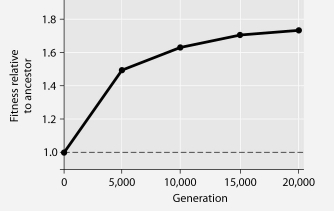Question 41
(Multiple Choice)
The following questions refer to Figure 27.1.
In this eight-year experiment, 12 populations of E. coli, each begun from a single cell, were grown in low-glucose conditions for 20,000 generations. Each culture was introduced to fresh growth medium every 24 hours. Occasionally, samples were removed from the populations, and their fitness in low-glucose conditions was tested against that of members sampled from the ancestral (common ancestor) E. coli population.

Figure 27.1
-If the vertical axis of Figure 27.1 refers to "Darwinian fitness," then which of the following is the most valid and accurate measure of fitness?
A) number of daughter cells produced per mother cell per generation
B) amount of ATP generated per cell per unit time
C) average swimming speed of cells through the growth medium
D) amount of glucose synthesized per unit time
E) number of generations per unit time
Answer